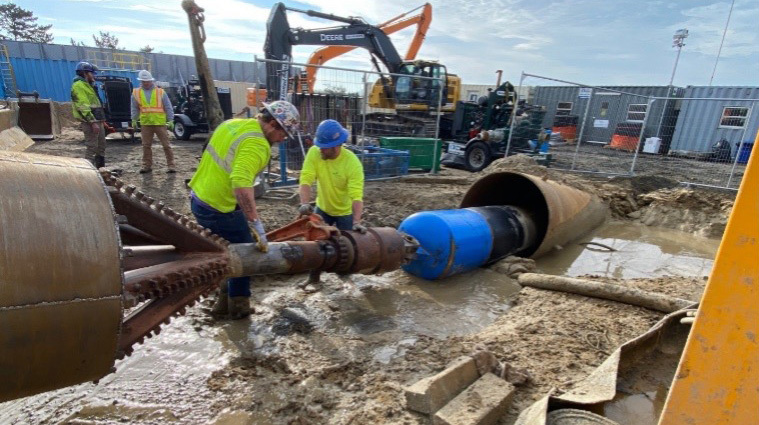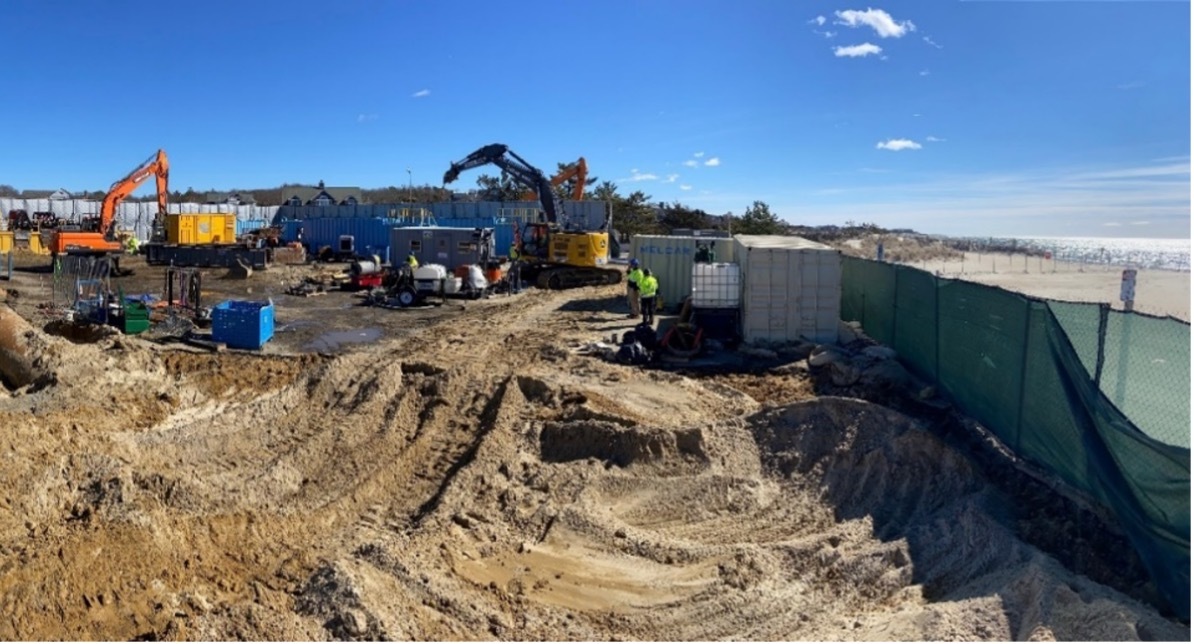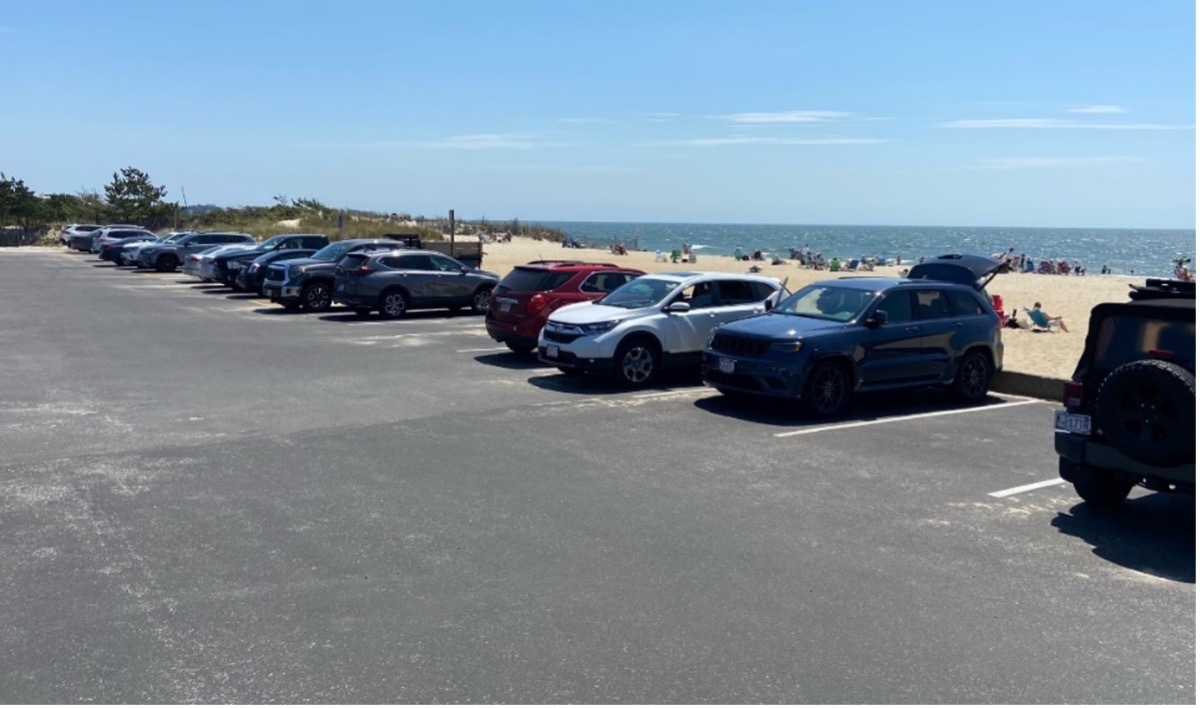"Vineyard Wind 1” Comes Ashore at Covell’s Beach, Barnstable
Author: Jack Vaccaro, Senior Consultant at Epsilon Associates
September 15th, 2022
Vineyard Wind 1: Offshore and Onshore
The Vineyard Wind 1 offshore wind farm, a Joint Venture between AVANGRID and Copenhagen Infrastructure Partners (CIP)(3) is located on the outer continental shelf in federal waters designated as wind energy areas approximately 15 miles south of Martha’s Vineyard and 35 miles east of mainland Massachusetts. (View map.) Vineyard Wind 1 will deliver 800 MW of clean energy to the northeast beginning in 2025, enough electricity to power approximately 400,000 Massachusetts homes, reducing carbon emissions in the atmosphere by over 1.6 million tons per year.
The first phase of Vineyard Wind 1’s onshore construction has included work at its future substation site (located in nearby Hyannis) and the installation of several miles of buried duct bank that will house the power cables beneath municipal roads between Covell’s Beach and the substation. Work also included the installation of two 42-inch conduits beneath Covell’s Beach and a nearshore segment of the Nantucket Sound seabed by means of below-surface horizontal directional drilling (HDD) – a specialized construction method used to minimize environmental impact – in preparation for submarine cable-pulling scheduled to commence later this year.

AVANGRID, Inc., a sustainable energy company and part of the IBERDROLA Group, recently finalized an agreement to assume responsibility as the operations and management services provider for Vineyard Wind 1, the first commercial-scale offshore wind project in the United States. Vineyard Wind 1, an 800-megawatt offshore wind project owned in a 50-50 Joint Venture between AVANGRID and Copenhagen Infrastructure Partners (CIP) funds CI II and CI III., is currently under construction off the coast of Massachusetts.
State and Federal Mandates and Incentives
The Commonwealth of Massachusetts has set a goal of developing enough renewable energy projects to heat homes and power vehicles with minimal use of fossil fuels by 2050 (Massachusetts Clean Energy and Climate Plan for 2025 and 2030). To achieve a statewide 50% GHG emissions reduction economy-wide below the 1990 baseline in 2030, GHG emissions from the electricity sector must decrease by more than 53% by 2025 and 70% by 2030(4). Offshore wind plays a pivotal role in this near-miraculous conversion.
The recently passed federal Inflation Reduction Act of 2022(5) includes significant financial incentives to spur on the development of renewable energy projects, including funding for interregional and offshore wind electricity transmission planning, modeling, and analysis, and generous tax credit incentives. Almost 300 pages of the legislation addresses clean energy credits and incentives estimated at $258 billion over a 10-year period, according to the Congressional Research Service(6).
With such laws and mandates now in place, it has become abundantly clear that coastal states will rely heavily on privately developed offshore wind to help close the gap between current and future carbon emission reduction targets.
At the height of construction, the parking lot at Covell’s Beach was almost entirely occupied by the specialized equipment and supplies required for the HDD operations. The work required substantial excavations within the paved parking area, which was ultimately restored following the completion of the work. In the end, the work at Covell’s Beach was completed on schedule and when the beach crowds returned on Memorial Day weekend, there was little evidence that ground-breaking construction of the nation’s first offshore wind farm had occurred over the prior winter. A recently paved parking lot and some newly installed manhole covers were the only visible signs of the recently completed installation.
Jack Vaccaro, a Senior Consultant at Epsilon Associates, Inc., and life-long resident of Cape Cod, served as the on-site environmental monitor for the duration of the Vineyard Wind HDD operations at Covell’s Beach and was responsible for ensuring permit compliance for both onshore and offshore operations. In this capacity, Jack was granted full access to this unique construction spread which enabled Epsilon to provide valuable compliance guidance and regulatory liaison services to Vineyard Wind on a day-to-day basis.
Postscript - Epsilon continues to work closely with the developers and the Bureau of Energy Ocean Management (BOEM) to permit other offshore wind projects along the U.S. east coast.
For additional information please contact jvaccaro@epsilonassociates.com
For more information regarding Vineyard Wind 1, go to www.vineyardwind.com/vineyardwind-1
Offshore Wind Permitting: Complex, Painstaking, Essential
FEDERAL
Bureau of Ocean Energy Management (BOEM)
Environmental Protection Agency
Army Corps of Engineers
United States Coast Guard
Federal Aviation Administration
National Marine Fisheries Service
STATE & LOCAL
MA Department of Environmental Protection
Energy Facilities Siting Board
US Environmental Protection Agency,
MA Division of Marine Fisheries
MA Department of Fish and Wildlife
Cape Cod Commission.
Barnstable Conservation Commission
© 2022 Epsilon Associates, Inc. All rights reserved.
(1) Bethany Card (Secretary of Energy and Environmental Affairs, Commonwealth of Massachusetts), Massachusetts Clean Energy and Climate Plan for 2025 and 2030, June 30, 2022, p. 79.
(2) Business Wire, AVANGRID Reaches Agreement to Operate First-in-the-Nation Vineyard Wind 1, August 3, 2022.
(3) AVANGRID, Inc., a sustainable energy company and part of the IBERDROLA Group, recently finalized an agreement to assume responsibility as the operations and management services provider for Vineyard Wind 1, the first commercial-scale offshore wind project in the United States. Vineyard Wind 1, an 800-megawatt offshore wind project owned in a 50-50 Joint Venture between AVANGRID and Copenhagen Infrastructure Partners (CIP) funds CI II and CI III., is currently under construction off the coast of Massachusetts.
(4) op. cit., Massachusetts Clean Energy and Climate Plan for 2025 and 2030, p. 79
(5) H.R.5376 Inflation Reduction Act of 2022, August 16, 2022.
(6) Delloite, Advancing energy security: Sustainability-related tax provisions in the Inflation Reduction Act. August 18, 2022.

